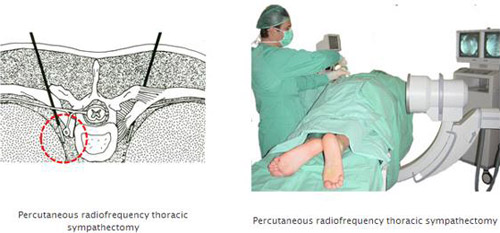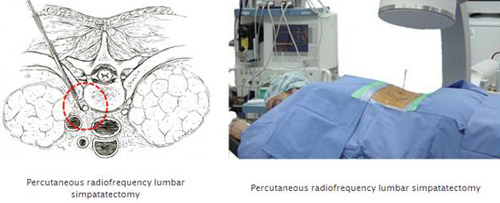عرق کردن یکی از مهمترین راههایی است که بدن برای از دست دادن گرما استفاده میکند. با این وجود، برخی افراد از تعریق بیش از حد رنج میبرند. میزان عرق کردن در مناطق خاصی از بدن این افراد، بیش از حد نرمالی است که برای کنترل دمای بدن لازم است.
هایپرهیدروزیس، اصطلاح پزشکی برای تعریق بیش از حد میباشد. از هر 200 نفر، یک نفر مبتلا به هایپرهیدروزیس است. این مشکل معمولاً از سنین نوجوانی و جوانی شروع شده و به دلیل بیش فعالی غدد عرق ایجاد میشود. غدههای عرق با انواع خاصی از اعصاب به نام سیستم اعصاب سمپاتیک تغذیه میشوند که یکی از وظایف آن کنترل تعریق است. افزایش فعالیت سیستم اعصاب سمپاتیک میتواند منجر به هایپرهیدروزیس اولیه (Essential/Primary Hyperhidrosis) شود که علت بروز آن هنوز ناشناخته است و ظاهراً بیشتر مربوط به مسائل ژنتیکی است. تعریق بیش از حد میتواند از نوع ثانویه (Secondary) نیز باشد که به دنبال فعالیت غده تیروئید یا آدرنال یا بیماری مرض قند ایجاد میشود.
عرق زیاد قسمت های مختلف بدن مانند عرق کف دست، عرق کف پا، زیر بغل و سر و صورت یک مشکل رایج در برخی افراد است. گاهی این مشکل بسیار شدید و آزاردهنده می شود، به طوری فعالیت های اجتماعی شخص را دچار مشکل می کند. روش های جراحی و غیر جراحی مختلفی برای درمان تعریق کانونی (تعریق زیاد بخش هایی از بدن) وجود دارد. تعریق عمومی (تعریق زیاد کل بدن) نیز، با برطرف کردن علت زمینه ای تعریق کنترل می شود.
درمان های عرق زیاد بدن
برای درمان تعریق زیاد میتوان از روشهای زیر استفاده کرد:
الکترولیز
استفاده از دارو
تزریق سم بوتولینیوم
سمپاتکتومی جراحی
سمپاتکتومی با RF
درمانهای معمول همچون پماد هیدروکسید آلومینیم یا جراحی غدد عرق توسط لیزر ممکن است قادر به کنترل هایپرهیدروزیس اولیه نباشند و یا حتی منجر به ایجاد برخی عوارض جانبی شوند. در این موارد، سمپاتکتومی میتواند مفید باشد. سمپاتکتومی یک تکنیک جراحی است که هدف آن از بین بردن بخشی از عصب میباشد که با غدههای عرق موجود در پوست مرتبط هستند. جراحی سمپاتکتومی توراسیک میتواند برای کنترل تعریق زیر بغل، دستها و پاها و سردی دست و پا به کار میرود.
سمپاتکتومی جراحی
سمپاتکتومی ناحیه قفسه سینه (برای دستها و زیر بغل) : سیستم اعصاب سمپاتیک از داخل قفسه سینه به زیر بغل و دستها عصبرسانی دارد و به این ترتیب دسترسی به آن برای جراحان مشکل است. امروزه به دلیل پیشرفت ابزارهای لاپاروسکوپی نوین، استفاده از سمپاتکتومی توراسیک از طریق توراکوسکوپی بسیار گسترش یافته است.
در این عمل جراحی، بیمار تحت بیهوشی عمومی قرار میگیرد. سپس یک دوربین توراکوسکوپ از طریق چند برش کوچک یک سانتیمتری که پایینتر از ناحیه زیر بغل بین دندهها ایجاد شده است، وارد قفسه سینه (T3) میشود. برای اینکه پزشک بتواند عصبها را به وضوح ببیند، ریه در سمت مربوطه، توسط متخصص بیهوشی و با کمک one-lung ventilation خالی میشود. ابزار لاپاروسکوپی دوم از طریق برش دیگری وارد شده و هر عصب و زنجیره سمپاتیک توسط کوتر و چاقو بریده میشود.
سمپاتکتومی ناحیه کمر (برای پاها) : اعصاب سمپاتیک که غدههای عرق پاها توسط آنها عصبرسانی میشوند در ناحیه پشت شکم (خلف صفاق) قرار دارد. عمل سمپاتکتومی کمری از گردنی پیچیدهتر است. این عمل معمولاً به صورت عمل جراحی باز با استفاده از برشهای کوچکی در ناحیه کناری شکم انجام میشود. بیشتر بیماران پس از عمل یک شب در بیمارستان بستری میشوند و دوران ریکاوری کامل حدود 2 تا 4 هفته خواهد بود.
سيستم سمپاتیک و نقش آن در کنترل تعریق
سیستم سمپاتیک در مقابل سیستم پاراسمپاتیک قرار دارد. یکی از وظایف خاص سیستم سمپاتیک کنترل درجه حرارت مرکزی و محیطی بدن از طریق کنترل تعریق در بدن است.
اختلال در عملکرد این سیستم میتواند باعث افزایش تعریق در قسمتهای مختلف بدن شود. سیستم اعصاب سمپاتیک از لحاظ آناتومیک در قسمت محیطی و کنار ستون فقرات به صورت زنجیری قرار دارد. پیش از این، جهت درمان اختلالات سیستم سمپاتیک (همچون تعریق بیش از حد دستها و زیر بغل) از روش جراحی و بیهوشی عمومی برای قطع این سیستم (سمپاتکتومی) استفاده میشد که همراه با عوارض بود. اخیراً با پیشرفتهایی که در تکنیکهای اینترونشنال کنترل درد صورت گرفته است میتوان بدون نیاز به بیهوشی عمومی و جراحی باز این عمل را انجام داد.
سمپاتکتومی با رادیوفرکوئنسی
عمل سمپاتکتومی از طریق رادیوفرکوئنسی (RF) نیز قابل انجام است. این روش در معدود مراکز درمانی و کلینیکهای تعریق انجام گرفته است و در ایران نیز تنها توسط دکتر باقرزادی انجام میشود. سمپاتکتومی از طریق رادیوفرکوئنسی یک روش غیرتهاجمی محسوب میشود که در آن هیچ نیازی به بیهوشی کامل، تخلیه ریه یکطرفه و برش جراحی نیست. روش رادیوفرکوئنسی سمپاتکتومی قفسه سینه یا کمری، در شرایط اتاق عمل و توسط دستگاه راهنمای اشعه x (C-armed Flouroscopy) انجام میشود. محل زنجیره سمپاتیک از طریق تست لیدوکائین 1% و همچنین تجویز ماده حاجب و عکسبرداریهای متعدد تأیید میگردد. در سمپاتکتومی با رادیوفرکوئنسی، سوزنهای RF که بسیار باریک هستند، از خلف قفسه سینه (پس از بیحسی موضعی) وارد گردیده و پس از عبور از فضای بین دندهای در کناره خلفی مهرهها، در محلی که زنجیره سمپاتیک قرار دارد، جای میگیرد. نوک فعال سوزنهای RF عایق ندارد، همین دلیل، وقتی در مجاورت زنجیره سمپاتیک قرار میگیرد، امواج ساطع شده از آن، حرارتی به اندازه 80 درجه سانتیگراد تولید میکند که در مدت دو دقیقه میتواند باعث تخریب زنجیره سمپاتیک شود. این کار منجر به از بین رفتن کامل تعریق ناحیه دست، زیربغل یا پاها میشود.
در طی مدت عمل، بیمار کاملاً بیدار است و همکاری نزدیکی با جراح دارد. همچنین پس از عمل، بیمار میتواند به منزل بازگردد و کارهای روزانه خود را از سر گیرد.

روش سمپتاتکومی کمری با RF و به صورت زیر پوستی برای بیمارانی با مشکلات عروقی در اندامهای پایین تنه و همچنین در موارد دردهای نوروپاتیک قابل استفاده است. در درمان با رادیوفرکوئنسی از انرژی الکترومغناطیسی در نزدیکی بافت عصب استفاده میشود.

نتایج حاصل نشان میدهد که برای درمان تعریق بیش از حد، استفاده از سمپاتکتومی قفسه سینه بیشترین اثر را دارد. همچینی استفاده از سمپاتکتومی با RF در مقایسه با سمپاتکتومی جراحی توصیه میشود؛ چرا که سمپاتکتومی باRF، نیازی به بیهوشی عمومی ندارد و بدون برش جراحی صورت میگیرد. علاوه بر این، بکارگیری RF برای درمان تعریق، عوارض کمتری داشته و با دوران ریکاوری کوتاهتری همراه خواهد بود. همچنین رفلکس هایپرهیدروزیس بیمار پس از سمپاتکتومی با RF نسبت به سمپاتکتومی جراحی کمتر است.
با کمک خداوند متعال، عمل سمپاتکتومی قفسه سینه با امواج رادیویی بدون نیاز به بیهوشی و جراحی توراکوسکوپیک جهت درمان تعریق کف دست و زیر بغل، برای اولین بار در ایران و برای دومین بار در سطح بینالملل توسط دکتر کامبیز باقرزادی با موفقیت و بدون عوارض انجام شده است.
سمپاتکتومی جهت درمان مشکلات دیگری همچون نارساییهای عروقی ناشی از دیابت یا درمان بیماری برگر و نیز دردهای مزمن در اندامها به کار میرود. پس با روش سمپاتکتومی با RF میتوان به این بیماران نیز کمک کرد.











